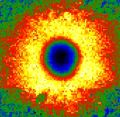Speaker
Description
Plasmonic or generally nanophotonic systems have been usually investigated by optical and electron beam spectroscopic methods. However, as a rule, each of them has been applied for individual samples separately without direct comparison of their results. We take up this challenge and report on the correlative electron and optical spectroscopy applied for an exploration of fundamental phenomena associated with nanostructured systems possessing both infrared phonon polaritons (PhPs) and plasmon polaritons (PPs). More specifically, we have studied an electromagnetic coupling between MIR PhPs in a silicon dioxide membrane and low-energy localized surface plasmon (LSP) modes formed by the confinement of PPs in micrometre-long gold antennas. We have found that far-field IR spectra can be substantially different from EEL spectra, which we confirm by experiments supported by numerical simulations and analytical modelling. We show that by precisely positioning the electron beam, the coupling between the polaritonic excitations can selectively trigger either uncoupled PhPs or coupled LSPs/PhPs. Based on our understanding of the focused-beam excitation of the polaritonic system, we also present a post-processing analysis in the EEL spectra that facilitates the identification of the new hybrid modes and allows an easier comparison to the far-field optical spectra.
In addition to this study, we will present a complementary analysis of the electromagnetic coupling between localized surface plasmons in gold rectangular antennas and MIR PhPs in a silicon dioxide thin film on a semi-infinite silicon substrate. Even though the underlying principles in this system have been previously described, we complement these results with a detailed analysis of the resultant hybrid modes based on a coupled oscillator model, realistic SiO2 dielectric function, as well as by the calculation of the Hopfield mixing coefficients.

